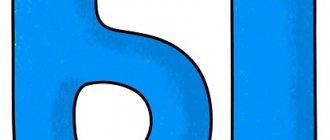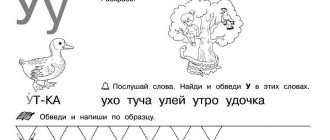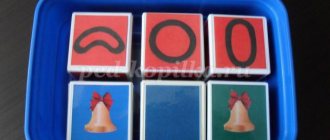Setting the sound “SH”
The sound “Ш” is dull, soft in pronunciation, described in some cases as Шь.
Articulation of the sound “Ш”: the tip of the tongue must be raised to the alveoli while pressing the lateral edges of the tongue against the upper teeth. The muscles should be tense. When exhaling, press the tip of your tongue onto the roof of your mouth. The lips take on a rounded shape. The distance between the teeth should be no more than five millimeters.
Raising your hand to your mouth, you can feel a stream of warm air as you exhale. There is no vibration because the sound is dull. The sound Шь is produced after the pronunciation of Ш is normalized. The sound Шь, unlike Ш, is pronounced more drawn-out and tense. When spoken, the tongue presses on the roof of the mouth.
“SH” can appear independently after all the hissing sounds have been produced. If this does not happen, special speech therapy techniques are used. You should start with imitation exercises. In this case, the child is offered play techniques (imagine a hissing snake, a small train).
Be sure to use tactile techniques to check for correct articulation.
When the correct sound pronunciation occurs, the child is asked to pronounce the sound for a long time, stretching out a smile and pushing the tongue forward, until the sound appears.
Articulation
The key to good pronunciation is the correct articulation of the sounds sh and zh. To teach a child to pronounce the letters sh and z correctly, it is necessary to study one method of articulation, since the speech apparatus works almost identically when pronouncing both letters. So, in order to correctly pronounce the letter w, it is necessary to work with the articulatory apparatus as follows:
- the baby's lips should be slightly pushed forward in the shape of a tube;
- the tip of the tongue is raised to the palate so that a small gap remains between them;
- the lateral edges of the child’s tongue are pressed against the upper outer teeth, giving the tongue the shape of a cup;
- a stream of air easily passes through the unused vocal cords, creating the necessary sound.
In order to understand how to teach a child to say the letter z, it is necessary to resort to the articulation described above, while connecting the vibrations of the vocal cords. Regular exercises for making sounds are very important. These exercises can be done with a speech therapist or at home.
Frontal speech therapy lesson in the senior group on the topic “Sound and the letter Sh.” Abstract
Speech therapy session in the senior group.
Sound and letter Sh. Description: This lesson was conducted in a senior speech therapy group. When preparing the lesson, the emphasis was on the development of the phonetic-phonemic aspect of speech in children. This lesson will be useful for speech therapists and preschool teachers. Purpose: To introduce children of senior preschool age to the sound “SH”. Objectives: 1. Teach children to characterize the sound “Ш” according to acoustic and articulatory characteristics.
2. Develop general, fine and articulatory motor skills of children. 3. Develop phonemic processes. 4. Practice analyzing words and sentences. 5. Instill in children self-control over newly introduced sounds. Progress of the lesson
1. Organizational moment Guys, let's greet each other with a song.
Logorhythmic greeting “Hello palms”
2. Announcement of the topic of the lesson.
The speech therapist puts a picture of Snakes on the board.
Who is this?
How does a snake hiss? (sh-sh-sh)
Today we will get acquainted with this sound.
3. Acoustic-articulatory image of sound. Pronunciation of an isolated sound Ш with the connection of oral, tactile-vibrational and acoustic control. Observing the position of articulation in the mirror: the lips are extended forward, the wide tongue is raised to the alveoli and creates a barrier to the air stream that passes through the middle of the tongue, the vocal cords do not vibrate (the neck is silent). The sound Ш is a consonant, dull, always hard, denoted by a blue chip. 4. The connection between sound and letters. Examination of the letter Ш. The letter Ш is like a scallop. Comb the doll, my friend! We put three teeth in a row and connect them at the bottom. 5. Development of phonemic hearing. The speech therapist names correct and incorrect sounding words.
Children should clap their hands when they hear the correct word. Cap, slipper, hat, cap.
Balysh, kids, kavysh, tabysh. Maiba, Kaiba, Thaiba, puck. Takhmats, chess, bakhmats, khammatas. 6. Physical exercise. Performing movements according to the text of the poem.
All the guys stood up together and walked in place. They stretched on their toes and turned to each other. We sat down like springs, and then sat down quietly. 7. Consolidation of sound in syllables. Sound analysis of syllables АШ, ША. The speech therapist lays out diagrams of syllables on the board, and the children say which diagram fits which syllable. 8. Consolidating sounds in words. The speech therapist hangs pictures on the board whose names contain the sound Ш. Children must sort these pictures into 3 groups: the sound Ш at the beginning of the word, in the middle of the word and at the end of the word. After this, the words are divided into syllables. Then the speech therapist, together with the children, conducts a detailed sound analysis of the word “shawl” and lays out a graphic diagram. 9. Fixing sound in sentences. Working on a deformed phrase. Children are asked to make sentences from words. There is porridge on the table. The drivers have a leather cap. 10. Fixing sound in text. Isolating words with the sound Ш from the text. The little animal is jumping - Not a mouth, but a trap. The frog will get both a mosquito and a fly. 11. Summary of the lesson. What sound does a snake make? What sound is this? Name words with the sound Ш at the beginning, in the middle, at the end of the word.
We recommend watching:
Summary of an individual educational activity with a 5-6-year-old pupil for the correction of sound pronunciation. Notes of an educational activity in a senior speech therapy group. Notes of a lesson in a senior speech therapy group. Notes of an individual correctional and developmental speech therapy lesson. Senior group
Similar articles:
Summary of educational activities in the older group of children with severe speech impairments on the topic: “Sounds S - Z”
Summary of educational activities in the senior group of children with severe speech impairments on the topic: “Sounds S - Sh”
Summary of a subgroup GCD to eliminate disturbances in sound pronunciation in children of the older group with severe speech impairments
Summary of educational activities in the senior speech therapy group on the topic “Cossacks and their traditions”
Logorhythmic lesson for children of senior preschool age with special needs on the topic: “What types of transport are there?”
Automation of the sound [ш] in syllables
Consolidation of sounds in syllables, words, sentences must be carried out in the form of a full-fledged lesson or homework. In order for the child to be actively involved in the lesson process, it must take place in a playful way.
It is necessary to prepare in advance the equipment that will be used. These could be toys, drawings with sound, methodological developments, speech therapy tools.
Mimic gymnastics
Classes begin with special articulatory gymnastics, which will prepare the speech apparatus for the exercises and relax the facial muscles.
Mimic gymnastics includes the following exercises:
- Move your lips left and right, stretching your facial muscles. Perform five times in one direction and the other, rest, repeat four more times.
- Alternately puff out your cheeks, repeating the exercise five times with a short rest.
- Frown your eyebrows, pout your lips, making an offended, capricious face. Practice an angry facial expression by pursing your lips. Make a surprised expression by raising your eyebrows. Repeat each exercise four to five times.
- Alternate rapid blinking with calm, relaxed opening and closing of the eyes.
- Trace the contour of your lips with your tongue, as if licking the remnants of jam or ice cream on your face.
- Make faces, make funny facial expressions, form your lips like a duck.
Each exercise can be accompanied by a poetic rhyme or an entertaining story. In this way, the child will not only develop facial expressions, but also train speech and memory.
Breathing exercises. Making the sound Ш while inhaling
Introducing the sound Ш to a child can be done step by step with the help of breathing exercises.
The most successful is the sound pronunciation through T. First, you need to ask the child to pronounce the sound T for a long time by touching the tip of the tongue to the inside of the upper teeth. The sound should produce a stream of air, which is noticeable when you bring your palm to your mouth. Then you need to exhale the air and make the sound T with a short breath.
The child should draw in air without using the larynx. It is necessary to draw in air until the tongue rests firmly on the alveoli. The sound should be similar to a rustling sound, which at the same time releases a chill on the cavity of the upper teeth.
After a rustling sound is heard, it is important to push the air back out with a sound after drawing in. At this stage you should get a soft Sh.
Positioning must be done carefully with short rests to avoid hyperventilation, which can lead to dizziness.
Mechanically assisted setting
To produce some sounds, special speech therapy instruments are used that help control the movement of the tongue and lips.
Mechanical placement can be done from the sound C. During prolonged pronunciation, a special probe in the form of a spatula is used to lift the child’s tongue to the upper teeth, moving it slightly back. After receiving the sound Ш, you should try to pronounce it without the help of instruments.
It is possible to have an effect when pronouncing the sound R. To do this, the child must, without a voice, stretch out, pronounce the sound R. Using the tip of the instrument, it is necessary to stop the vibration under the tongue until a hiss appears. After a certain number of repetitions, the hissing will occur involuntarily.







